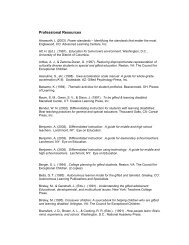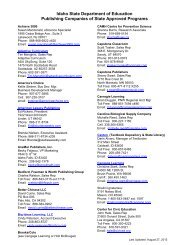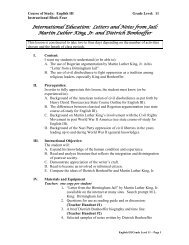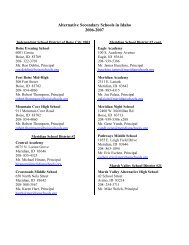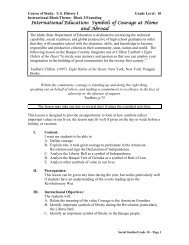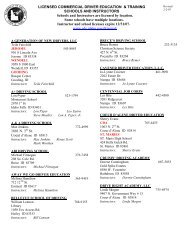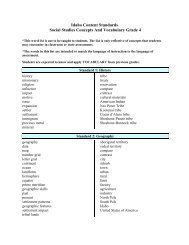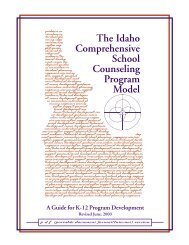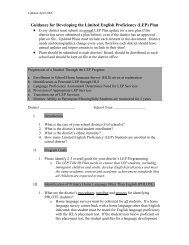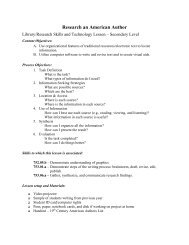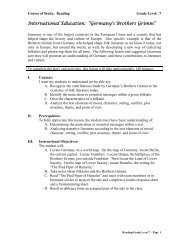Create successful ePaper yourself
Turn your PDF publications into a flip-book with our unique Google optimized e-Paper software.
Unit of Instruction<br />
<strong>Origami</strong><br />
Big Ideas<br />
<strong>Origami</strong> – Sonobe Unit and Sonobe Cube created by Mitsonobu Sonobe<br />
Geometry Concepts<br />
• Lines, intersections, shapes, and spatial visualization<br />
Rationale<br />
This origami project will enhance students’ understanding of two- dimensional polygons<br />
as well as their problem solving skills to create three-dimensional shapes from a flat<br />
two-dimensional surface.<br />
NCTM 9-12 Standards<br />
• Analyze characteristics and properties of two- and three-dimensional geometric<br />
shapes and develop mathematical arguments about geometric relationships.<br />
• Apply transformations and use symmetry to analyze mathematical situations.<br />
• Use visualization, spatial reasoning, and geometric modeling to solve problems.<br />
• Understand how mathematical ideas interconnect and build on one another to<br />
produce a coherent whole.<br />
• Use the language of mathematics to express mathematical ideas precisely.<br />
Idaho Content Standards<br />
• G.4.1.1 Analyze properties and determine attributes of two- and threedimensional<br />
objects.<br />
• G.4.1.2 Explore congruence and similarity among classes to twodimensional<br />
objects and solve problems involving them.<br />
• 9-12.VA.1.1.1 Identify representative visual works of art from a variety of cultures<br />
and historical periods.<br />
• 9-12.VA.3.3.1 Plan and produce a work of art applying media, techniques, and<br />
processes with skill, confidence, and sensitivity.
Geometry and Art: <strong>Origami</strong><br />
Vocabulary<br />
Background<br />
Math <strong>Origami</strong><br />
Angle bisectors Color side down<br />
Conjectures Color side up<br />
Constructions Fold and crease<br />
Midpoint Insert in pocket<br />
Parallel lines Mirroring<br />
Parallelograms Modular pieces<br />
Perpendicular bisectors Mountain fold<br />
Perpendicular lines Rotate<br />
Polyhedra Sonobe<br />
Reflection Squash fold<br />
Segment bisectors Turn over<br />
Stellated icosahedron Valley fold<br />
Stellated octahedron<br />
Stellated tetrahedron (cube in this project)<br />
Symmetry<br />
Tiling<br />
Math Instruction (pre- or post-project)<br />
Pre-project Instruction<br />
Basic concepts of origami: vocabulary, symbols<br />
See examples of common symbols used in origami at the following websites:<br />
http://library.thinkquest.org/5402/terms.html<br />
http://members.tripod.com/~PeterBudai/<strong>Origami</strong>/Symbols_en.htm<br />
http://www.geocities.com/Rachel_Katz/origami/symbols.htm<br />
Section 8 Page 100
Geometry and Art: <strong>Origami</strong><br />
Project Objective<br />
Driving Question<br />
Construct a Sonobe Cube using six congruent Sonobe Units.<br />
Research student selected Sonobe unit and modular origami constructions.<br />
Questions to be Answered<br />
How do misinterpreted directions lead to problems with your final product?<br />
If you fold the wrong side (right vs. left) in step 5, page 8, will the unit still work? If you<br />
make six mirror units will they still work to make a cube?<br />
Which geometric shapes did you recognize while you were folding? (squares, triangles,<br />
what kind of triangles)<br />
What kind of symmetry does a Sonobe Unit have?<br />
How do these Sonobe Units relate to tessellations?<br />
What kinds of polyhedra can be constructed with Sonobe Units? What types of<br />
symmetry does each have?<br />
How many Sonobe Units are needed to construct each polyhedron? Compare the<br />
number of Sonobe Units required in the each form. What patterns are apparent? [Hint:<br />
patterns may be easier to find if you count in 3-unit blocks and think about how they<br />
relate to regular polyhedra.]<br />
A polyhedron is said to be n-colorable if it can be made with no two adjacent units in the<br />
same color when you use n colors of paper. Which Sonobe polyhedron is 2-colorable?<br />
3-colorable? 4-colorable?<br />
Questions from the following website: (Math on the Street Project)<br />
www.math.serenevy.net/?page=origami/challenge<br />
Section 8 Page 101
Geometry and Art: <strong>Origami</strong><br />
Materials Required<br />
Materials<br />
Square Paper: Many types of square paper can be used. Here is a short list of paper<br />
types that work well.<br />
o <strong>Origami</strong> Paper<br />
� www.asianfoodgrocer.com has very inexpensive origami paper<br />
o Patty Paper (also called wax serving paper).<br />
� Can be found at restaurant supply stores or online.<br />
o 12 x 12 Scrapbook Paper<br />
� Can be found at any scrapbook supply store<br />
o Magazine paper cut into squares<br />
o Regular notebook or printer paper cut into squares<br />
o Square sticky notes<br />
A device to crease the folds.<br />
o Popsicle sticks, tongue depressor, bone folder, student ID cards, etc<br />
References<br />
CloudRunner Inc. <strong>Origami</strong>: The Secret Life of Paper (Interactive CD). Salinas, CA:<br />
Cassady & Greene, 1984.<br />
Fuse, T. Unit <strong>Origami</strong>: Multidimensional Transformations. Tokyo, Japan: Japan<br />
Publications, 1990.<br />
Kawamura, M. Polyheadron <strong>Origami</strong> for Beginners. Tokyo, Japan: Kawamura & Nihon<br />
Vogue Co., 2001.<br />
Neale, R. & Hull, T. <strong>Origami</strong> Plain and Simple. New York: St. Martin’s Press, 1994.<br />
Simon, L., Arnstein, B., & Gurkewitz, R. Modular <strong>Origami</strong> Polyhedra. New York: Dover<br />
Publications, 1999.<br />
Franck, Betsy. Unfolding Mathematics with Unit <strong>Origami</strong>. Key Curriculum Press, 1999.<br />
Great site for how to fold unit and how to put them together into polyhedra<br />
http://roberttgasperson.com/articleblog/2007/08/19/how-to-fold-origami-how-tomake-the-sonobe-module-unit/<br />
Good diagrams of folding basic sonobe unit and putting two units together:<br />
http://www.math.lsu.edu/~verrill/origami/sonobe/<br />
Good diagrams of sonobe unit assembly into polyhedra:<br />
http://www.akpeters.com/previews/Mukerji_Excerpt.pdf<br />
Assembly of sonobe cube: http://britton.disted.camosun.bc.ca/origami/sonobe.html<br />
There are also some good videos on YouTube<br />
For example: http://www.youtube.com/watch?v=XcxJLScCyEo&feature=related<br />
Section 8 Page 102
Geometry and Art: <strong>Origami</strong><br />
Day One<br />
Day Two<br />
Day Three<br />
Lesson Outline<br />
• Teacher demonstrates how to fold a basic Sonobe unit as students follow<br />
along with their own paper. During this process, the teacher should introduce<br />
origami terms, symbols, and types of folds (10 minutes)<br />
• Students practice folding a basic Sonobe unit until they have correctly folded<br />
6 units. (15-20 minutes).<br />
• Once all students have correctly folded 6 basic Sonobe units, teacher<br />
demonstrates how 3 units can fit together to form one “corner” of the cube (5<br />
minutes).<br />
• Students practice forming “corners”. Then have students try and assemble 2<br />
of the “corners” together to form a cube (10-20 minutes).<br />
• Teacher has 6 basic Sonobe units prepared. Teacher or a student revisits<br />
how 3-unit corners are constructed, and how 2 of the “corners” can be<br />
assembled together to form a cube (5 min).<br />
• Take cube apart and teacher demonstrates how to assemble the “corners” so<br />
that they become stellated faces of larger polyhedra (refer to<br />
octahedron/icosahedron assembly directions) there must be pictures and<br />
directions included in the materials for this to work (5 min).<br />
• Have students decide if they want to make a stellated octrahedron (requires<br />
12 units) or a stellated icosahedron (requires 30 units). Allow students to fold<br />
Sonobe units and attempt to assemble into the polyhedra of their choice (30<br />
min).<br />
• Finish cubes. Work with students who are still struggling…don’t give up.<br />
• Analyze folds and the piece as a whole.<br />
• What do you see?<br />
• What creates the structural strength?<br />
• Choose topics for research including all origami and further Sonobe Units<br />
(optional).<br />
• Begin research on extension project (optional).<br />
Section 8 Page 103
Geometry and Art: <strong>Origami</strong><br />
Rubric<br />
Assessment<br />
Sonobe Cube (100 points possible)<br />
Neatness: 20 points<br />
Problem Solving (fixing any incorrect steps): 20 points<br />
Accuracy: 60 points<br />
Optional Research Paper/Project (100 points possible)<br />
Technical Writing: 10 points<br />
Creativity: 20 points<br />
Exploration: 20 points<br />
Content: 50 points<br />
Optional Student Driven Class Demonstration of Research Project (100 points )<br />
Peer Assessment: 50 points<br />
Teacher Assessment: 50 points<br />
Ideas for Further Independent Student Projects<br />
This could easily expand into a senior project.<br />
Modular <strong>Origami</strong> research.<br />
Kirigami research.<br />
Research on Mitsonobu Sonobe.<br />
Complex origami units.<br />
Extension: Demonstrate advanced Sonobe unit. Note: this is a VERY neat variation on<br />
the basic fold and is a worthwhile extension as it makes the polyhedra really “pop”.<br />
• Teacher demonstrate advanced fold as students follow along with their own<br />
paper. Once teacher and/or students have successfully folded 3 units,<br />
demonstrate how advanced units assemble to form stellated faces (10<br />
minutes).<br />
Section 8 Page 104
Geometry and Art: <strong>Origami</strong><br />
<strong>Origami</strong> is the Japanese art of paperfolding. This project focuses on unit origami. Each<br />
unit is made with one piece of paper. Then these are put together with many units<br />
folded the same way and assembled in various ways to create different geometric<br />
shapes. This unit fold was designed by Sonobe Mitsurobu, and thus is called the<br />
Sonobe Cube.<br />
Take care to make crisp folds. Your patience here will make assembly easier and the<br />
final object will be much neater in appearance.<br />
Mitsunobu Sonobe is an origamian who created the popular Sonobe Module, which<br />
she used to make a simple 6-unit cube in modular origami. Later, Kunihiko Kasahara<br />
used the Sonobe module to discover many other regular and semiregular polyhedra,<br />
some requiring up to 900 Sonobe units to complete. These Sonobe-module polyhedra<br />
are published in <strong>Origami</strong> for the Connoisseur by Kunihiko Kasahara and Toshie<br />
Takahama. Japan Press, 1998. ISBN 4-8170-9002-2<br />
MY DEFINITION OF A SONOBE:<br />
A Sonobe is a unit that has all of the following properties:<br />
• has two points or inserting tabs<br />
• has two pockets (where points go in)<br />
• two units can lock into each other to form a flat module<br />
Section 8 Page 105
Geometry and Art: <strong>Origami</strong><br />
<strong>Origami</strong> Glossary<br />
This page contains definitions for many of the terms used in origami design. The<br />
contents are adapted and expanded from <strong>Origami</strong> Design Secrets.<br />
A<br />
Active path: a path whose length on the crease pattern is equal to its minimum length<br />
as specified by the tree graph.<br />
Active reduced path: a reduced path within a universal molecule whose length on the<br />
crease pattern is equal to its minimum length as specified by the tree graph.<br />
Arrowhead molecule: a crease pattern within a quadrilateral that consists of a<br />
Waterbomb molecule combined with an angled dart; it allows an arbitrary four-circle<br />
quadrilateral to be collapsed while aligning the four tangent points.<br />
Atom: a portion of a crease pattern that corresponds to a segment of a single flap<br />
within a molecule.<br />
Axial crease: a crease in a crease pattern that lies along the axis in the folded form of a<br />
uniaxial base.<br />
Axial polygon: a polygonal region of paper in a crease pattern outlined by axial<br />
creases. In the folded form, the entire perimeter of an axial polygon lies along the axis<br />
of the base.<br />
Axis: a line on a base along which the edges of flaps lie and to which the hinges of<br />
flaps are perpendicular.<br />
B<br />
Base: a regular geometric shape that has a structure similar to that of the desired<br />
subject.<br />
Bird Base: one of the Classic Bases, formed by petal-folding the front and back of a<br />
Preliminary Fold.<br />
Blintzing: folding the four corners of a square to the center<br />
Blintzed base: any base in which the four corners of the square are folded to the center<br />
prior to folding the base.<br />
Branch edge: in a tree graph, an edge that is connected to two branch nodes.<br />
Branch node: in a tree graph, a node connected to two or more edges.<br />
Branch vertex: a point in the crease pattern that corresponds to a branch node on the<br />
tree graph.<br />
Book symmetry: the symmetry of a crease pattern that is mirror-symmetric about a line<br />
parallel to an edge and passing through the center of the paper.<br />
Border graft: modifying a crease pattern as if you added a strip of paper along one or<br />
more sides of the square in order to add features to the base.<br />
Section 8 Page 106
Geometry and Art: <strong>Origami</strong><br />
Box pleating: a style of folding characterized by all folds running at multiples of 45°,<br />
with the majority running at multiples of 0° and 90° on a regular grid.<br />
C<br />
Circle/river method: a design technique for uniaxial bases that constructs the crease<br />
pattern by packing nonoverlapping circles and rivers into a square.<br />
Circle: the geometric shape within a circle-packed crease pattern that represents a leaf<br />
edge in the tree graph. That is, the circle identifies the minimum paper that must be<br />
allocated for a free flap.<br />
Circle packing: placing circles on a square (or other shape) so that they do not overlap<br />
and their centers are inside the square.<br />
Classic Bases: the four bases of antiquity (Kite, Fish, Bird, and Frog) that are related<br />
by a common structure.<br />
Closed sink fold: a sink fold in which the point to be sunk must be popped from convex<br />
to concave; it cannot be entirely flattened.<br />
Collapse: the general term for bringing together a large number of creases at once to<br />
form a base.<br />
Composite molecule: a molecule that contains axial creases in its interior.<br />
Corner flap: a flap whose tip comes from one of the corners of the square.<br />
Crease: a mark left in the paper after a fold has been unfolded.<br />
Crease assignment: determination of whether each crease is a mountain fold, valley<br />
fold, or flat (unfolded) crease. Also called crease parity.<br />
Crease pattern: the pattern of creases left behind on the square after a model has<br />
been unfolded.<br />
Crimp fold: a fold formed by two parallel or nearly parallel mountain folds and valley<br />
folds on the near layers of a flap with their mirror image folds formed on the far layers.<br />
Crystallization: the process of fixing the locations of circles in a circle packing by<br />
enlarging some of the circles until they can no longer move.<br />
Cupboard Base: a traditional base consisting of a square with two opposite edges<br />
folded toward each other to meet in the middle.<br />
D<br />
Decreeping: rearranging several trapped layers of paper so that no layer is wrapped<br />
around another.<br />
Detail folds: folds that transform the flaps of a base into details of the finished subject.<br />
Diagonal symmetry: the symmetry of a crease pattern that is mirror-symmetric about<br />
one of the diagonals of the square.<br />
Dihedral angle: the angle between the two surfaces on either side of a crease, defined<br />
as the angle between the surface normals.<br />
Section 8 Page 107
Geometry and Art: <strong>Origami</strong><br />
Distorted base: a modified base formed by shifting the vertices of the crease pattern so<br />
that the paper can fold flat; the number of creases and vertices remains the same, but<br />
the angles between them change.<br />
Double-blintzing: folding the four corners of a square to the center twice in succession.<br />
Double rabbit-ear fold: a fold in which the creases of a rabbit ear are made on the<br />
near layer of a flap and the mirror-image creases are made on the far layer.<br />
Double sink fold: two sink folds formed in succession on the same flap.<br />
E<br />
Edge: in a tree graph, a single line segment. Each edge corresponds to a unique flap or<br />
connector between flaps in the base. See leaf edge, branch edge.<br />
Edge flap: a flap whose tip comes from one of the edges (but not a corner) of the<br />
square. An edge flap has twice as many layers as a same-size corner flap.<br />
Edge weight: a number assigned to each edge of a tree graph that represents the<br />
length of the associated flap.<br />
Efficiency: a measure of how much paper is used to obtain features of the subject<br />
versus extra paper that is merely hidden away.<br />
Elias stretch: A maneuver used in box pleating to create flaps from a pleated region of<br />
paper, by changing the direction of the pleats by 90° within wedges of paper.<br />
F<br />
Fish Base: one of the Classic Bases, formed by folding all four edges of a square to a<br />
common diagonal and gathering the excess paper in two flaps.<br />
Flap: a region of paper in an origami shape that is attached only along one edge so that<br />
it can be easily manipulated by itself.<br />
Folded edge: an edge created by folding.<br />
Four-circle quadrilateral: a quadrilateral formed by connecting the centers of four<br />
pairwise tangent circles; such a quadrilateral can be folded so that all edges lie on a line<br />
and the tangent points between pairs of circles touch.<br />
Frog Base: one of the Classic Bases, formed by squash- and petal-folding the four<br />
edges of a Preliminary Fold.<br />
G<br />
Generic form: a crease pattern within a molecule or group of molecules in which (a) all<br />
axial creases are shown as mountain creases; (b) all ridgeline creases are shown as<br />
valley creases; and (c) all hinge creases are shown as unfolded creases. The generic<br />
form is an approximation of the actual crease pattern of a folded base.<br />
Grafting: modifying a crease pattern as if you had spliced into it a strip or strips of<br />
paper in order to add new features to an existing base.<br />
Section 8 Page 108
Geometry and Art: <strong>Origami</strong><br />
Grafted Kite Base: a family of bases composed by adding a border graft to two sides of<br />
a Kite Base.<br />
Gusset: one or more narrow triangles of paper, usually formed by stretching a pleat or<br />
crimp.<br />
Gusset molecule: a crease pattern within a quadrilateral that resembles a partially<br />
stretched Waterbomb molecule with a gusset running across its top. The gusset<br />
molecule, like the arrowhead molecule, allows any four-circle quadrilateral to be<br />
collapsed while aligning the tangent points.<br />
H<br />
Hex pleating: a design technique similar to box pleating but that uses triangles,<br />
hexagons, and hexagonal rivers for packing and all creases run at multiples of 30°.<br />
Occupies a role halfway between circle packing and box pleating in terms of both<br />
efficiency and regularity.<br />
Hinge: a joint between two flaps.<br />
Hinge creases: creases that in a uniaxial base are perpendicular to the axis. Hinge<br />
creases define the boundaries of flaps or segments of a base.<br />
Hole: a region of paper in a box-pleated crease pattern that does not belong to any<br />
atom.<br />
Hybrid base: a base that is constructed using multiple design techniques.<br />
Hybrid reverse fold: a more complicated form of reverse fold that combines aspects of<br />
both inside and outside reverse folds.<br />
I<br />
Ideal split: a technique for splitting a Kite Base flap, which gives the longest possible<br />
pair of flaps.<br />
Inflation: the process of adding circles to a crease pattern (corresponding to adding<br />
flaps to a base) and expanding the circle (lengthening the flap) until it touches 3 or more<br />
others. Inside reverse fold (page 25): a method of changing the direction of a flap,<br />
wherein the moving layers are inverted and tucked between the stationary layers.<br />
Inside reverse fold: a way of changing the direction of a flap in which the moving<br />
layers are inverted and pushed between two of the layers of the flap.<br />
J<br />
K<br />
Kite Base: the simplest of the Classic Bases, formed by folding two adjacent edges of a<br />
square to the same diagonal.<br />
L<br />
Leaf edge: in a tree graph, an edge connected to at least one leaf node.<br />
Leaf node: in a tree graph, a node connected to only a single edge.<br />
Section 8 Page 109
Geometry and Art: <strong>Origami</strong><br />
Leaf vertex: a point in the crease pattern that corresponds to a leaf node on the tree<br />
graph.<br />
M<br />
Middle flap: a flap whose tip comes from the interior of the square. A middle flap has<br />
twice as many layers as a same-sized edge flap and four times as many as a corner<br />
flap.<br />
Mixed sink fold: a sink fold containing aspects of both open and closed sinks.<br />
Molecule: a crease pattern which when folded flat has its perimeter lie along a common<br />
line and for which specified points along the perimeter (the tangent points) become<br />
coincident in the folded form.<br />
Mountain fold: a crease that is concave downward. Usually indicated by a dot-dot-dash<br />
line in sequential diagrams or a solid black line in crease patterns.<br />
N<br />
Node: in a tree graph, an endpoint of a line segment. See leaf node, branch node.<br />
O<br />
Offset base: a modified base formed by shifting the entire crease pattern on the square<br />
while preserving angles between creases, so that extra paper is created in some<br />
locations while others lose paper.<br />
Open sink fold: a sink fold in which the point to be sunk can be entirely flattened during<br />
the course of the sink.<br />
<strong>Origami</strong>: the art of folding paper into decorative shapes, usually from uncut squares.<br />
<strong>Origami</strong> sekkei: see technical folding.<br />
Ortholinear river: the analog of a river in box-pleated designs. The river has constant<br />
vertical and horizontal width and bends only at 90° angles.<br />
Outside reverse fold: a method of changing the direction of a flap, wherein the moving<br />
layers are inverted and wrapped around the stationary layers.<br />
P<br />
Parity: see Crease assignment.<br />
Path: a line between two leaf vertices in the crease pattern.<br />
Path conditions: the set of all inequalities relating the coordinates of the leaf vertices,<br />
the distances between their corresponding nodes, and a scale factor. The distance<br />
between any two vertices must be greater than or equal to the scaled distance between<br />
their corresponding nodes as measured along the tree.<br />
Petal fold: a combination of two squash folds in which a corner is lengthened and<br />
narrowed.<br />
Section 8 Page 110
Geometry and Art: <strong>Origami</strong><br />
Pseudohinge crease: a hinge crease in a unaxial base whose projection is not a node<br />
of the underlying tree.<br />
Plane of projection: a plane containing the axis of the base and the axial edges of all<br />
flaps, and that is perpendicular to the layers of the base.<br />
Plan view: a model is folded in plan view if when it lies flat you are looking at the top of<br />
the subject.<br />
Pleat fold: a fold formed by two parallel or nearly parallel mountain folds and valley<br />
folds formed through all layers of a flap.<br />
Pleat grafting: adding one or more pleats that run across a crease pattern in order to<br />
add features or textures formed by the intersections of the pleats.<br />
Plug: a crease pattern that is used to fill in holes in box-pleated patterns.<br />
Precreasing: folding and unfolding to create the creases required for a (usually<br />
complex) step or an entire base.<br />
Point-splitting: any of a variety of techniques for folding a single flap so that it turns<br />
into two or more (smaller) flaps.<br />
Preliminary Fold: a traditional base formed by bringing the four corners of the square<br />
together.<br />
Pythagorean stretch: a technique in box pleating in which two diagonally-oriented leaf<br />
vertices are allowed to move closer to each other than the square packing would<br />
normally permit. This results in the creation of axial creases and ridgeline creases at<br />
angles other than 0°, 45°, and 90° in the vicinity of the stretch but permits greater<br />
efficiency in the crease packing.<br />
Q<br />
R<br />
Rabbit-ear fold: a way of turning a triangular corner into a flap, consisting of folding<br />
along all three angle bisectors of the triangle and gathering the excess paper into a flap.<br />
Rabbit-ear molecule: the pattern of creases within a triangle that collapses its edges to<br />
lie on a single line.<br />
Raw edge: the original edge of the paper, as opposed to an edge created by folding.<br />
Reduced path: a path between two inset vertices created during the construction of the<br />
universal molecule.<br />
Reduced path inequality: n inequality condition analogous to the path condition that<br />
applies to inset vertices and paths in the universal molecule.<br />
Reverse fold: a way of changing the direction of a flap by folding different layers of the<br />
flap in different directions. The two most common forms are the inside reverse fold and<br />
the outside reverse fold.<br />
Section 8 Page 111
Geometry and Art: <strong>Origami</strong><br />
Ridgeline crease: a crease within a molecule that propagates inward from the corners<br />
of the molecule. Ridgeline creases are always valley folds when viewed from the interior<br />
of a molecule.<br />
River: a usually-curved or rectangular constant-width region in a tile or crease pattern<br />
that creates a segment between groups of flaps in the folded form.<br />
S<br />
Sawhorse molecule: a crease pattern within a quadrilateral similar to the Waterbomb<br />
molecule, but with a segment separating the two pairs of flaps. Also known as the<br />
Maekawa molecule.<br />
Scale: a quantitative measure of efficiency. The scale of a crease pattern is the ratio<br />
between the length of a folded flap and the length of its corresponding edge in the tree<br />
graph.<br />
Shaping: the folds that transform an abstract, geometric base into the finished figure.<br />
Side view: a model is folded in side view if when the model lies flat you are looking at<br />
the side of the subject.<br />
Sink fold: inversion of a point. Sink folds come in several different types.<br />
Splitting points: see point-splitting.<br />
Spread sink fold: a sink fold in which the edges of the point are spread and the point<br />
flattened. Similar to a squash fold.<br />
Square/river packing: the analog of circle and river packing that allows box-pleated<br />
crease patterns.<br />
Squash fold: a fold in which the edges of a flap are spread, usually symmetrically, and<br />
the edges flattened.<br />
Standard bases: the most common origami bases, usually taken to include the Classic<br />
Bases plus the Windmill Base, Cupboard Base, Preliminary Fold, and Waterbomb Base.<br />
Stretched Bird Base: a form of the Bird Base in which two opposite corners are pulled<br />
apart to straighten out the diagonal that connects them.<br />
Strip graft: modifying a crease pattern as if you spliced in one or more strips of paper<br />
running across a crease pattern in order to add features to the base.<br />
Stub: a new edge added to the tree graph attached to a new node introduced into the<br />
middle of an existing edge and associated creases added to the crease pattern. Adding<br />
a stub allows four path conditions to be simultaneously satisfied as equalities.<br />
Subbase: a portion of a base, usually consisting of a single axial polygon.<br />
Subtree: the tree graph that is the projection of a subbase.<br />
Swivel fold: an asymmetric version of a squash fold in which the two valley folds are<br />
not collinear.<br />
Section 8 Page 112
Geometry and Art: <strong>Origami</strong><br />
T<br />
Tangent points: points along axial polygons where circles (or rivers) touch each other<br />
and are tangent to the hinge creases.<br />
Technical folding: origami designs that are heavily based on geometric and<br />
mathematical principles.<br />
Three-step model: a universal description of the general folding sequence for a model<br />
designed by technical folding. The three steps are: (1) precreasing; (2) collapse; (3)<br />
shaping.<br />
Tile: a portion of a crease pattern, usually consisting of one or more axial polygons and<br />
decorated by circles and rivers, that can be assembled into crease patterns by matching<br />
circle and river boundaries.<br />
Tree: short for tree graph.<br />
Tree graph: a stick figure that represents a uniaxial base, in which each edge of the<br />
tree represents a unique flap or connection between flaps.<br />
Tree theory: the body of knowledge that describes the quantitative construction of<br />
crease patterns for uniaxial bases based on a correspondence between features of a<br />
tree graph and features in the crease pattern.<br />
Tree theorem: the theorem that establishes that satisfying the path conditions is both<br />
necessary and sufficient for the construction of a crease pattern for a given tree graph.<br />
Triangulation: the process of decomposing high-order axial polygons in a crease<br />
pattern into smaller polygons that are all order-3, i.e., triangles.<br />
U<br />
Unfold: removing a valley fold or mountain fold (or a group of same), leaving behind<br />
one or more creases.<br />
Uniaxial base: a base in which all flaps lie along a single axis and all hinges are<br />
perpendicular to the axis.<br />
Universal molecule: a generalization of the gusset molecule that can be applied to<br />
every valid axial polygon.<br />
Unsink: removing a sink fold, or turning a closed sink fold from concave to convex.<br />
V<br />
Valley fold: a crease that is concave upward. Usually indicated by a dashed line in<br />
sequential folding diagrams and a dashed or colored line in crease patterns.<br />
Vertex: a point in a crease pattern where multiple creases come together. See leaf<br />
vertex, branch vertex.<br />
Section 8 Page 113
Geometry and Art: <strong>Origami</strong><br />
W<br />
Windmill Base: a traditional base that looks like a windmill.<br />
Waterbomb Base: a traditional base formed by bringing the midpoints of the four edges<br />
of a square together.<br />
Waterbomb condition: a quadrilateral satisfies the Waterbomb condition if and only if<br />
the sums of opposite sides are equal. A quadrilateral that satisfies this condition can be<br />
folded into an analog of the traditional Waterbomb Base.<br />
Waterbomb molecule: a crease pattern within a quadrilateral that resembles the<br />
traditional Waterbomb. Also called the Husimi molecule.<br />
X<br />
Y<br />
Yoshizawa split: a technique for splitting a Kite Base flap, in which the point is first<br />
sunken, followed by two spread sinks.<br />
Z<br />
Section 8 Page 114
Geometry and Art: <strong>Origami</strong><br />
Section 8 Page 115
Geometry and Art: <strong>Origami</strong><br />
Basic Unit/Cube<br />
The Units<br />
To make the Sonobe Cube, six identical units must be folded. It is important to do all the<br />
folds the same way. Reversing/mirroring step three will change the unit so that it will not<br />
fit with the others. After identically folding the six units required, fold one more unit and<br />
mirror step three by making the corner folds on the opposite corners and continuing on<br />
with the folds. You will find that this unit will, in no way, fit properly with the other six<br />
units you have folded.<br />
The Assembly<br />
About the only thing to note here is that<br />
the units are at right angles to each other.<br />
I hope this drawing gives enough detail<br />
into the assembly. It is so much easier to<br />
be shown this in real space.<br />
The Basic Sonobe cube<br />
Section 8 Page 116
Geometry and Art: <strong>Origami</strong><br />
Mathematical Instructions for Sonobe Cube Unit<br />
1. Start with a square.<br />
2. Fold in half. This fold is a midsegment of the square. Unfold.<br />
3. Fold top side down to midsegment. Do not unfold.<br />
4. Fold bottom side up to midsegment. Do not unfold.<br />
5. Fold lower left vertex to top side to create a trapezoid.<br />
6. Spin (turn 180 degrees).<br />
7. Fold lower left vertex to create a parallelogram.<br />
8. Unfold to original square.<br />
9. Fold vertices of upper left and lower right corners to the closest parallel quarter<br />
segment.<br />
10. Fold lower side up to lower quarter segment.<br />
11. Fold top side down to upper quarter segment.<br />
12. Fold lower left vertex up to upper quarter segment.<br />
13. Scrunch fold.<br />
14. Spin (rotate 180 degrees).<br />
15. Fold lower left vertex up under top flap (create a parallelogram with two folded<br />
rectangles in the middle).<br />
16. Flip over.<br />
17. Fold lower right and upper left vertices to create a square.<br />
You have now created a Sonobe Unit. Create 6 units to make a Sonobe Cube. Fit<br />
each of the six units together keeping the units at right angles to each other.<br />
Section 8 Page 117
Geometry and Art: <strong>Origami</strong><br />
Sonobe Unit<br />
The photo above is taken of a variation of a Sonobe cube, an advanced unit. What<br />
follows is a step-by-step pictorial guide to creating one.<br />
1<br />
2<br />
Section 8 Page 118
Geometry and Art: <strong>Origami</strong><br />
3 4<br />
5 6<br />
7 8<br />
9 10<br />
Section 8 Page 119
Geometry and Art: <strong>Origami</strong><br />
11 12<br />
13 14<br />
After inserting each of the tabs of all 6 pieces into their pockets, (don’t leave any on the<br />
inside), you will have a cube. Next, pull the scrunch folded centers out and away from<br />
the centers of each side of the cube. Do this on each of the six sides to create a<br />
beautiful stellated Sonobe unit. If your folds are accurate and crisp, it will be very strong<br />
and will hold together beautifully. Have fun, and try different forms.<br />
Section 8 Page 120



